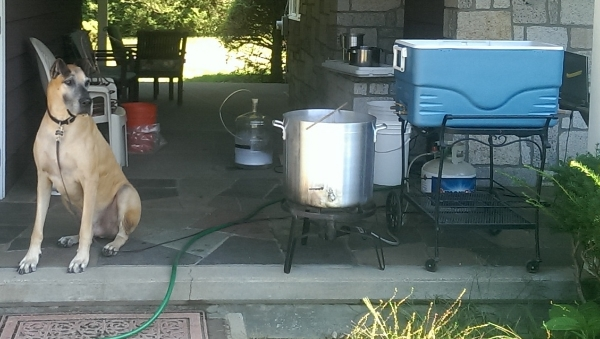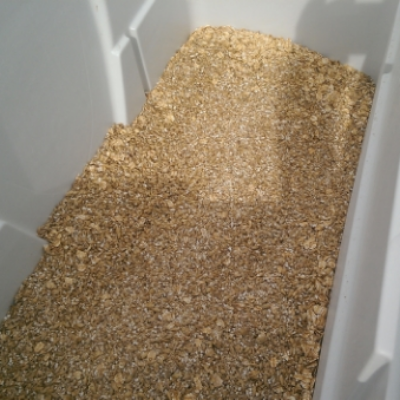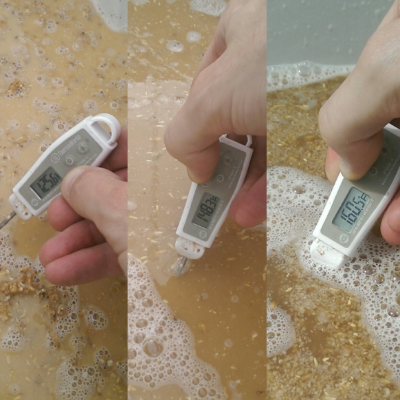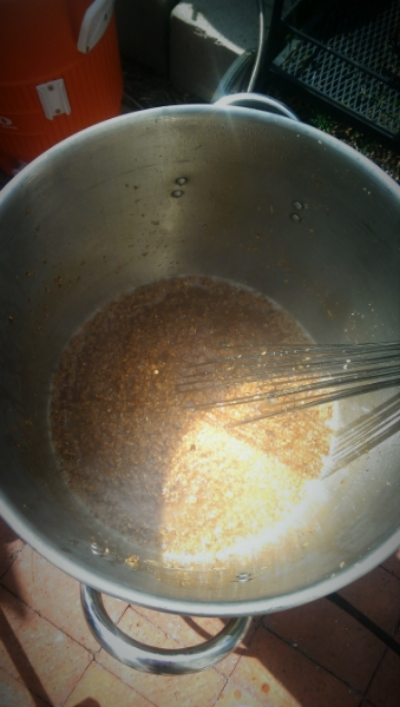unTraditional Bock
The first series of beers I'll talk about here are all for a national competition called the BrewUnited Challenge. The crux of the challenge that there are only 4 grains and 6 hops you can use. Each recipe must contain all 4 grains and only 2 of the 6 hops. There are three categories Malty, Balanced, and Hoppy, all with a handful of specific styles within each category. For the competition, I decided to brew a traditional bock, a blonde ale, and an amber ale. Judging by the title of the blog post, you probably guessed that this post will deal with my take on the traditional bock using the constraints of the competition and you'd be 100% right.
After a quick perusal of the Traditional Bock style guidelines, I came up with the following recipe for a 5.5 gallon batch of beer:
- 8 lbs Munich - Light
- 3 lbs German Pilsner
- 1 lb Crystal 60L
- 1 lb flaked wheat (toasted on a baking sheet at 300F until golden)
Mash low at 143F
Boil for 3 hours to build flavor and color
Boil Additions:
- 0.25oz Perle and Challenger hops @60 minutes
- Irish Moss @15 minutes
- 0.25oz Perle and Challenger hops @15 minutes
Fermentation Plan:
- Saflager 34/70 dry lager yeast
- Ferment using Brulosopher’s quick lager method
I can never let a recipe go unaltered for too long, so I looked at some more recipes and let my initial take simmer in my mind for a bit. My first concern was using 1 full pound of Crystal 60L. At ~7.5% of the total grist, it seemed excessive to me, even though many recipes had that much (or more) of similar specialty grains, but I just couldn’t pull the trigger. I was worried about a cloying caramel sweetness that would over power the rich deep malt backbone from the Munich and Pilsner, especially since this is a low hopped beer, there would be not a lot of bitterness to cut through the sweetness. I then dropped the wheat because I didn’t want to fight haze with all the starches from the wheat and hoped that 4oz (just under 2%) of well toasted flaked wheat would add a bit of oomph to the beer, strangely, the color of the wheat didn’t change all that dramatically, but the smell and taste sure did. I bumped up the Munich and Pils to get the gravity more in range stylistically according to BeerSmith and increased the initial bittering charge of hops to again keep it more in style and to balance out the slight increase in gravity.
I then started to question the mash temperature and technique. I went back and forth quite a bit about doing decoctions versus step infusions, and couldn’t really decide what to do, so I ended up doing both. In the end I felt that doing step infusions to hit my main temps would be fine and then I would do a single decoction with a large portion of the grains to hit my final temp for the mashout. This was done both to darken the color of the beer to style guidelines and also to push melanoidin production that would give it more traditional flavor.
So after all that fussing, my final recipe for 5.5 gallons was:
- 10 lbs Munich - Light
- 3.5 lbs German Pilsner
- 4oz Crystal 60L
- 4oz Flaked Wheat (toasted 1.5hr at 300F)
Infusion step mash:
- 125F protein rest for 15 minutes
- Add boiling water to the mash to heat to 148F, hold for 30 minutes
- Add boiling water to the mash to heat to 162F , hold for 30 minutes
Decoction Step:
- Pull out 3 gallons of thick mash after 162F rest (almost all grain, liquid barely above the settled grain bed in the pot) and boiled the grain portion for 20 minutes
- Add the boiled grains back to mash to heat up to 168F, let sit for 15 minutes, drain (add rest of grains if needed) and sparge with remaining water at 168F
Boil for 90 minutes
Boil Additions:
- 0.4oz each Perle and Challenger hops @60 minutes
- Irish Moss @15 minutes
- 0.25oz each Perle and Challenger hops @15 minutes
Fermentation Plan:
- 3 packets of Saflager 34/70 dry lager yeast
- Ferment using Brulosopher’s quick lager method
Graiiiiiiiiiiiiiiins
So I had the recipe locked down, but I felt weird calling it a traditional bock because besides the recipe, my fermentation schedule was also a bit unorthodox, as you'll see below. So I decided to call it an unTraditional Bock. I brewed this beer in San Diego, and San Diego city water isn't the greatest for brewing straight from the tap, so for brew day, I picked up 12 gallons of reverse osmosis water (11 for mashing/boil, 1 for making a new batch of sanitizer). I treated the 11 gallons of water with 2 tsps each of gypsum and calcium chloride, heated up the strike water, and then doughed in for my protein rest. After the 15 minute protein rest, I added boiling water to get it up to 148F. 30 minutes later I added more boiling water to get it up to 162F (ended up at 160.5, but I didn't want to thin out the mash anymore, so I kept it at 160.5).
Bing, bang, bo...close enough.
30 minutes later I was pulling off most of the grain to boil, I ended up taking a bit more than 3 gallons and boiled and stirred for 30 minutes. There definitely was decent color change, but adding it back to the mash didn’t seem to darken it up as much as I had hoped. I decided to call an audible after draining my mashtun and sparging with the remaining water and upped my boil time to 105 minutes in hopes of darkening the wort just a few more steps on the SRM scale, with the added bonus of potentially gaining more complexity to the wort.
Almost looks like breakfast is ready.
After cooling down the wort to ~70F with the help of some ice, I filled my carboy and placed it in my fermentation chamber set at 50F for a few hours to cool completely down for pitching. I pitched 3 packets of rehydrated Saflager 34/70 yeast. After 7 days at 50F, I raised the temp by 5F per day until I got to 70F, there it sat for 5 days, then I dropped the temp to 32F in the chamber and let that sit for 4 days at 32F before racking into a CO2 purged keg.
Now here’s where things continue down the unTraditional path…I sealed the keg at 30PSI and the next day placed the keg delicately in the back of a semi trailer with all my worldly possessions where it spent 11 days slowly traversing the broiling desert Southwest, the uncomfortably hot Midwest, and why are you still so humid New England before reaching our new home. When the trailer arrived, I set up my kegerator and immediately got it cooling to serving temp and carbonating under CO2. I pulled the first pour, smelled it, and was extremely pleased; it was malty with a touch of sweetness (caramel raisin toffee goodness) and absolutely no hint of autolysis (I was most concerned about that, I had no idea how hot it would get in the back of the trailer). My first sip confirmed what my nose told me...no off flavors! Just a great backend sweetness that lingered for a bit that held up to the big malt presence. It was a little hazy, but as it’s been sitting and aging a bit, it’s getting clearer and clearer and the flavors are getting more rounded and pronounced. The hops may have been a little lost, yes it’s a malt forward beer, but it could have stood to be just a touch more bitter. The hop socks I’ve been using have probably cut down just a bit on utilization, so I should probably shoot for 10% more IBUs when designing recipes to get what I want. But all in all, it’s a fantastic beer and the more people I share it with, the more I feel like I have a winner.
Cheers!
This post was modified slightly and updated a bit from a piece I wrote for BrewUnited that can be found here.
Final Numbers on my unTraditional Bock:
- Batch Size: 5.5 gallons
- Original Gravity: 1.068
- Final Gravity: 1.017
- ABV: 6.7%
- IBU: 23.4




